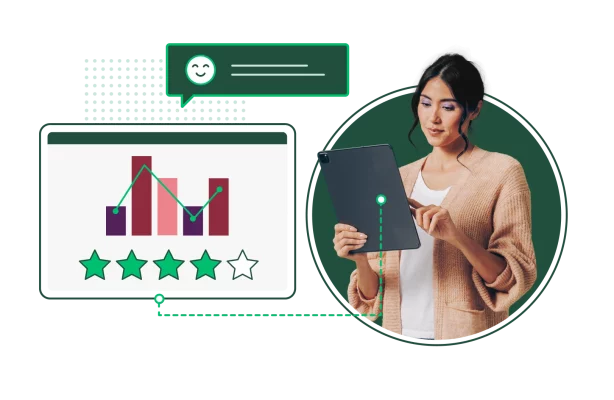20 customer loyalty survey question examples
20 essential customer loyalty survey questions and best practices for learning how your customers feel about you.

Your business revolves around delivering what your customer needs and value—a product, service, or experience. If you’re not giving your customers what they want, then they will look elsewhere for solutions that fit their needs. But how can you tell if your customers are truly happy with what you’re delivering? How can you figure out what’s not working well, and what you can do to improve?
That’s where customer loyalty surveys comes in. But it’s not enough to just ask customers if they’re happy—you should tailor your survey with the right questions to get actionable feedback. Not sure what to ask in your customer loyalty survey? We’ve got the most essential questions for you right here to ask your valued customers so you get the feedback you need.
What is a customer loyalty survey?
A customer loyalty survey is used to measure how your customers feel about your business or the experiences they have with your business.
While your customer loyalty questionnaire won’t cover every aspect of the customer experience, it should give you a good gauge of how happy or unhappy your customers are after they interact with your business at some point in the customer journey.
Why are customer loyalty surveys important?
Happy and loyal customers are vital to the success of your brand. In today’s heavily saturated business world, one of the biggest differentiators businesses can offer is an excellent customer service experience. If your company offers the same product as a competitor, but their customer service goes above and beyond yours, they will stand out, and you might get left behind.
Most companies understand this––it’s pretty logical! But too often, they assume they know how satisfied their customers are without asking them directly. It’s often harder than you think to guess what new features, services, or products your customers would truly value.
Customer loyalty surveys allow you to listen to your customers. You can ask customers directly what they think about what you offer. There is a range of brand loyalty surveys, so you can choose the one that fits your needs.
Types of customer loyalty surveys
There are three main types of customer loyalty surveys:
All three of these customer survey methodologies measure customer satisfaction and loyalty a little differently, so it’s vital to know which one suits your needs best before you launch your survey.
Customer Satisfaction Score (CSAT)
CSAT measures how satisfied your customers are with their overall experience with your company, or with a particular interaction or experience. Customer Satisfaction Score survey asks:
“How would you rate your overall satisfaction with the product (or service) you received?”
Respondents answer a scale with a rating (typically 1-5) assigned to each level of satisfaction:
- Very Unsatisfied
- Unsatisfied
- Neutral
- Satisfied
- Very Satisfied
After collecting customer responses, the next step is to calculate your company’s CSAT Score. Start by taking the number of satisfied customers (those who selected the top two choices in your scale, which is 4 and 5) and divide that number by the total number of survey responses. Then multiply by 100 to see the percentage of satisfied customers.
- (Number of satisfied customers (4 and 5) / Number of survey responses) x 100 = % of satisfied customers
So, if you had 2000 customers respond to your survey and 800 rated their experience a 4 or 5, your formula might look like:
- 800/2000 (.4) x 100 = 40% satisfied customers.
Net Promoter Score (NPS)
NPS is another widely used customer loyalty questionnaire. Net Promoter Score asks, “How likely are you to recommend this company to your family and friends?”
You calculate your NPS by subtracting your percentage of detractors (those who rate you a 6 or below) from your percentage of promoters (those who give you a 9 or 10). This score is easy to track over time, so you can check on your progress regularly.
- (Number of promoters (9 or 10)/Total Survey Response) - (Number of detractors (6 or below)/Total Survey Responses) = NPS.
Customer Effort Score (CES)
Customer Effort Score how easy customers can complete a specific task or achieve a particular goal when interacting with their products, services, or support channels. CES is designed to gauge customers' effort to resolve an issue, purchase, or accomplish any desired action.
The standard CES survey asks a single question and has customers rate their answer on a scale of 1 to 7. These are usually statements like “The customer service agent was knowledgeable and helpful about solving my issue.”

20 customer loyalty survey questions
If you’re wondering what questions to include in your customer feedback survey, begin selecting questions based on your goals for the survey. What elements of the customer lifecycle and journey do you want to know more about? This will help you narrow down the right questions for your survey needs.
1. How well does our product meet your needs?
This is a broad question that will give you specific and actionable results. If your products aren’t meeting your customers' needs, you’ll need to identify the gaps and make changes. You can also include an open-ended question to get additional context.
2. How would you describe our products?
Knowing how successfully you communicate your value proposition and product vision to your customers is important. Are they seeing the same qualities you intend them to, or are there gaps here? This question can be open-ended if you don’t want to direct answers, or you can make it multiple-choice if you’re interested in specific qualities.
3. How would you rate your experience with our product?
This question is how you get your CSAT number. Just divide the number of satisfied respondents by the total number of responses.
4. If you could change just one thing about our product, what would it be?
Knowing what your customers feel is missing from your product is important so that you can fix the issue. It might be something small, or it could be a major issue at play. But you won’t know until you ask.
5. What is your favorite aspect of the product, service, or tool?
This question can help you assess what’s working really well with your customers already. You can use this information to surface effective parts of your products and services and use those high points in your marketing and sales too.
6. Does the product help you achieve your goals?
Customers often buy products not just because they like them, but because they want those products to help them achieve specific goals in their lives. Understanding what these goals are for your customers can help you create marketing campaigns that work better, attracting even more customers to your business.
7. How often do you use the product or service?
This question can help your product team determine how your customer retention efforts are going. Are customers using what you offer once and then leaving? Or are they returning repeatedly because they love what you do?
8. How would you rate the value for money of the product?
Asking how the value of your product matches your prices can yield valuable information about how customers view your products. Would they pay more because they love your offerings so much? Or are you priced too high? This question is best asked at least two weeks after customers purchase a product, so they’ve had time to get the full value.
9. How easy is it to navigate our website?
While you may believe your website is user-friendly and efficient at helping customers find what they need, their perspective could be quite different. Understanding the actual user-friendliness of your online presence can play a crucial role in decreasing customer churn.
Related: Use this website feedback survey to assess your website and deliver a better online experience.
10. What was the reason for your visit to our website?
Knowing why customers visit your website is valuable and can offer additional ideas for new content or features. Maybe they’re hunting for more info on using your products, and you can build new user guides. Or maybe there’s a common follow-up question they have after a service, and you could proactively begin providing that in an email.
11. How easy was [feature] to use?
If you’ve recently built a new feature, you might be wondering if it’s working as you intended. Ask your customers to find out! That way, you can work out the bugs early on.
12. How likely are you to recommend us to your family and friends?
This is the Net Promoter Score question, which effectively measures how satisfied customers are with your products or services. If they're inclined to recommend your offerings to others, it's excellent for generating word-of-mouth referrals. However, if they're prone to sharing negative feedback, understanding why is essential. Ensure to include an open-ended option for customers to provide detailed feedback in their own words.
13. Will you purchase more products from us in the future?
One vital measure for the success of your business is how many customers return. If most of your customers make one purchase and don’t purchase again, you should find out what’s driving them away after making the initial purchase decision.
14. How would you feel if you could no longer use our products or services?
This question can help you measure customer loyalty and satisfaction. If customers are satisfied but wouldn’t be disappointed if they couldn’t use your products or services any longer, how can you increase that loyalty level?
15. Did your representative make you feel valued as a customer?
Setting up a customer service survey after a customer has an interaction with a customer support representative can help you evaluate how effective your customer service is. Additionally, it can help you get extra depth from Customer Effort Score surveys.
16. Was your problem or inquiry resolved quickly?
Customers may have questions for your customer service representatives or occasionally encounter issues with your products. Evaluating the speed and ease with which these problems are resolved is one of the most valuable questions to include in your customer service survey.
17. What can our employees do better?
Including open-ended customer loyalty questions about satisfaction with your customer service or in-store shopping experience can yield valuable insights you might not have been aware of. If you notice patterns in the verbatim feedback you’re getting, you can reinforce positive trends or fix ongoing issues faster.
18. How can we improve your experience with the company?
Another great open-ended question for your customer survey is asking customers what they feel your company lacks, without any guidance. This can surface surprising insights as you ask customers to be candid about what they feel you’re missing.
19. What’s working for you and why?
While open-ended brand loyalty questions to surface negative issues are great, don’t forget to ask customers what’s going well so you can build on your strengths! This is an especially great question because it asks for additional context around why customers like what they like about your business.
20. Do you have any additional comments or feedback for us?
You don’t know what you don’t know, so giving your customers a completely open-ended question allows them to tell you anything. It can give you insights you didn’t even know you were missing so you can take quick action.
Improve loyalty with customer feedback
Once you’ve decided to implement a customer loyalty questionnaire, the next step is to find tools to help create personalized customer loyalty surveys that can deliver the data you need to improve your operations and decision-making.SurveyMonkey can help. From templates for CSAT, NPS, and CES surveys to valuable data and resources to help you get the most from customer loyalty surveys, all the tools you need to improve customer satisfaction and brand loyalty at your business are at your fingertips.
Net Promoter, Net Promoter Score, and NPS are trademarks of Satmetrix Systems, Inc., Bain & Company, Inc., and Fred Reichheld.
Discover more resources

Customer satisfaction survey templates
Explore our customer satisfaction survey templates to rapidly collect data, identify pain points, and improve your customer experience.

Beyond CX: How SurveyMonkey + Salesforce turn feedback into revenue
SurveyMonkey + Salesforce turn feedback into revenue

Get the feedback you can act on with online evaluation forms
Unlock the power of feedback with SurveyMonkey's online evaluation forms. Start with our form builder today!

The complete guide to user experience metrics
Learn how to measure attitudinal and behavioral user experience (UX), and how UX supports better CX.
How to run a successful VoC program
See how you can boost customer engagement and drive loyalty with a VoC program.